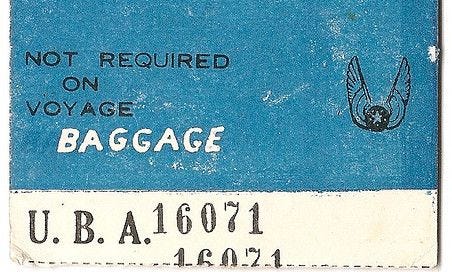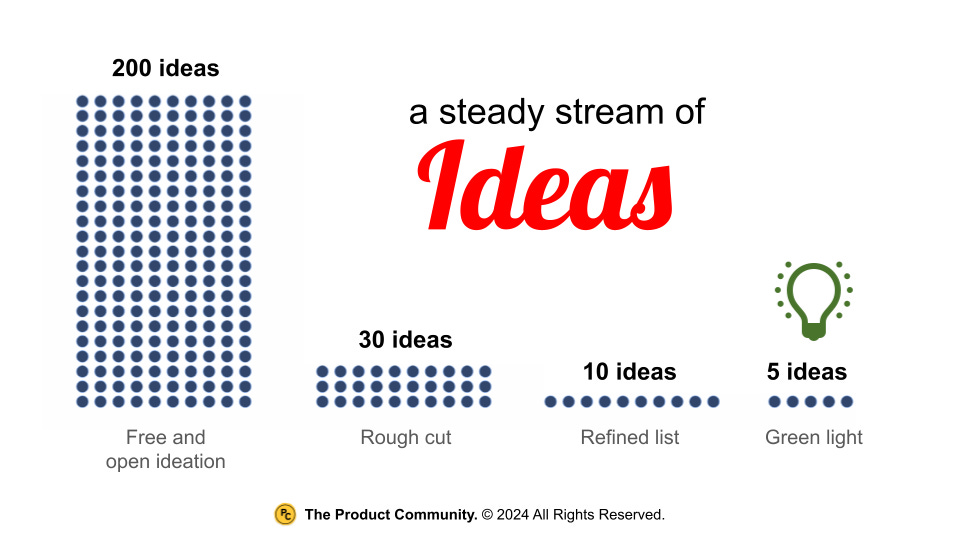Summary
This article highlights three ways to supercharge your annual meeting: to create suspense, for new idea generation, and as fuel for long-term engagement. Most associations design events as a way to gather, celebrate, learn, and connect. The great thing about them is that they work; people generally like them and, as post-COVID numbers indicate, they continue to be an important way to build community and drive revenue.
Outside of this, annual events are a cautious risk. They are cautious because they tend not to focus on big idea innovation. They are a risk because they are a protected cash cow forcing us to put most of our eggs in one basket. It doesn’t need to be this way. Let’s explore how to turn our annual events into incubators for cutting edge ideas.
The product community is a product development learning community designed specifically for associations.
The Importance of Innovation
“If an organization values innovation, you can assume it's safe to speak up with new ideas, leaders will listen, and your voice matters. Productive givers focus on acting in the long-term best interests of others, even if it's not pleasant.”
Adam Grant
I just got back from the annual meeting of the American Society of Association Executives (ASAE). Despite spending ten years in associations, I’m not super familiar with ASAE (I just became a member for the first time). As far as annual meetings go, there were no real surprises. There was an active expo hall, educational sessions, keynote sessions, and lots of after-hour receptions. I enjoyed myself, learned a few things, and met new people, but I also found myself wanting more.
Despite my zeal for the things associations offer – networking, learning, collaborative problem-solving, advocacy – I find most are too cautious and risk averse. I’m looking for something deeper, a venue for challenging the status quo. I want to engage deeply with what’s coming. Where will we be in ten years? What are our intractable problems and how might we solve them using innovation? How can we make deep and long-lasting impact?
In a previous article (Ten Skills for Innovators), I defined innovation as focused value creation. Scott Berkun takes it further: “Innovation is significant positive change. It’s a result. It’s an outcome. It’s something you work towards achieving. If you are successful at solving important problems, peers you respect will call your work innovative and you an innovator.”
Innovation is important for several reasons. Here are five:
Creating value. Being able to turn ideas into tangible value (products, etc.).
Solving problems. Being useful and solving problems for your community.
Differentiation. Being unique and hard to copy.
Agility. Being positioned to respond.
Recognizable. Being unmistakably clear.
Though innovation often seems elusive, it’s entirely achievable if we start small, think inclusively, and embed it thoughtfully into our annual events: as a dose of surprise, as an opportunity to tap the community for big ideas, and as a chance to seed future engagement.
Let’s dig into these further.
Idea Number One – Unveil New Products
“Innovation occurs when ripe seeds fall on fertile ground.”
Walter Isaacson
One way we can innovate the annual meeting is to create suspense while we unveil new, bold ideas for evolution. An oft-cited example is the annual Apple event.
The annual Apple event – where they unveil new products – is one of the most highly anticipated technology events of the year. Known as the Apple Keynote, it is a carefully orchestrated showcase of Apple's latest innovations.
Here’s why it works so well:
Anticipation and Hype – Apple has mastered the art of building intense anticipation and hype around its events. Through strategic leaks, teasers, and a cult-like following, Apple fans eagerly await each new product announcement.
Showmanship and Presentation – Apple's events are known for their cinematic production values. From the stage design to the presenter's delivery, Apple creates an immersive, theater-like experience that captivates the audience.
Product Unveiling – The main draw of the event is the unveiling of Apple's latest products. Whether it's a new iPhone, iPad, Mac, or a revolutionary technology, Apple knows how to build suspense and deliver a wow factor.
Ecosystem Integration – Apple's products are designed to seamlessly integrate within its broader ecosystem. The annual event showcases how the new products fit into and enhance the overall Apple experience.
To replicate the success of the annual Apple event, associations can consider the following:
Create a sense of anticipation – Build hype and anticipation around the event through a strategic marketing campaign, teasers, and exclusive leaks.
Invest in production value – Prioritize the event's overall presentation, from the stage design to the speaker's delivery. Aim to create an immersive, memorable experience.
Focus on product unveiling – Ensure that the main attraction of the event is the unveiling of new, innovative products or services that captivate the audience.
Emphasize ecosystem integration – Demonstrate how the new products or services integrate with an association’s broader ecosystem, creating a cohesive and compelling value proposition.
By incorporating these elements, we can create our own version of the highly successful annual Apple event, generating excitement, media attention, and ultimately, driving member engagement and loyalty.
Idea Number Two – Facilitate Community Idea Generation
“The innovator’s mindset can be defined as the belief that the abilities, intelligence, and talents are developed so that they lead to the creation of new and better ideas.”
George Couros
As annual meetings bring us together, it’s a great opportunity to tap our community for new ideas using design thinking: a human-centric, iterative, and creative way to solve problems in large and inclusive settings. It helps participants:
Gain deep empathy for peers
Challenge assumptions
Redefine problems
Create innovative solutions
Prototype and test rapidly
Design thinking is an excellent framework for idea generation (see my article A Steady Flow of Ideas). It emphasizes understanding user needs and creating innovative solutions. Here are some activities to anchor the concept:
Empathy mapping – Create detailed empathy maps for members to understand their needs, pain points, and motivations. This can spark ideas for solutions that directly address their concerns.
Open-ended questioning – Frame challenges as “how might we" questions to encourage open-ended thinking. For example, "How might we improve the engagement experience for busy members?"
Rapid ideation – Quickly sketch eight different ideas in eight minutes. This rapid ideation technique pushes participants to think beyond obvious solutions.
Analogous inspiration – Look at how similar problems are solved in completely different industries or contexts. This can lead to unexpected insights and ideas.
Persona-based ideation – Create fictional user personas and brainstorm ideas tailored to their specific needs and preferences.
Journey mapping – Map out the user's entire journey and identify pain points or opportunities for improvement at each step.
From the ideation process, comes voting on the best ideas. This can be framed as a fun and participatory. What excites? What’s compelling? What solves a tough to solve problem? What provides a ‘wow’ experience for members?
What’s important is that the process of generating ideas can find a foothold and can be translated into real initiatives that can be widely embraced and successfully executed. This happens when we engage our members, not just at an annual meeting, but meaningfully over time.
Idea #3 – Design for Sustained Engagement
“Design attitude demands changing one’s orientation from making decisions to creating options from which to choose.”
Alexander Osterwalder
One of my more popular articles is How to Productize Your Annual Meeting. It focuses on how to extend engagement beyond the annual gathering in order to position your members for longitudinal engagement. We do this as we want members to contribute more than attend, share more than listen, and shape more than consume.
Going a step further, we want our members to move beyond the known – their close-knit friends and existing networks – to meet new people, bring young professionals into the fold as we widen community and grow engagement. This way, we can transfer the single event into a series of experiences (over time) so members can find community, stay continually engaged, and keep our associations on the leading edge of what’s coming.
Here are thoughts on how it might work:
Think of the annual meeting less as a yearly destination and more as a way of building year-over-year momentum.
Think of the annual meeting as a major milestone on the way to building member-centric learning pathways.
Think of these learning pathways as competency-based or lily pads upon which members can focus in a particular area, build knowledge, and make connections.
Think of this knowledge and these connections as a powerful community of practice in which diverse members, stakeholders, sponsors, donors, insiders, and outsiders come together to create and sustain community.
Think of this community as solving tough problems in an environment of supercharged engagement, connection, buzz, and progress.
Annual events work. People like them. But why put all of our eggs in one basket? Why give the people only what they want (expo halls, sessions, food and beverage, and networking)? What if we were to re-think and re-position the experience so it serves as an incubator of innovation?
A Vibrant and Contagious Community of Practice
“Innovation is a team sport. In fact, an organization that depends on individual innovators alone is destined to fail.”
Larry Keeley
Despite its centrality to our operations, capabilities, identity, and revenue, the annual meeting is an underutilized vehicle for innovation.
The association of the future treats membership growth and diversified revenue as outcomes of great experiences. The way to achieve this is by using the annual meeting as an active petri dish or a place in which ideas can be identified, tested, and encouraged to develop. Ultimately, the annual event experience becomes a vibrant and contagious community of practice.
I lead the product community; we are a learning community because we believe great relationships help us create the value our members want. Remember, product-led growth fuels connection. Join the product community and flip your destiny.
About the Author
James Young is founder and chief learning officer of theproduct community®. Jim is an engaging trainer and leading thinker in the worlds of associations, learning communities, and product development. Prior to starting the product community®, Jim served as Chief Learning Officer at both the American College of Chest Physicians and the Society of College and University Planning. Please contact me for a conversation: james@productcommunity.us







